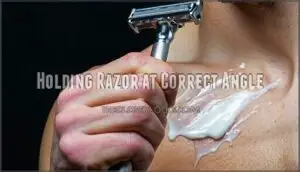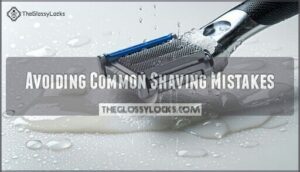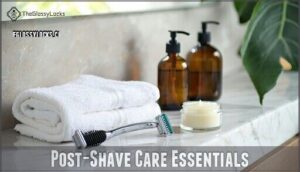This site is supported by our readers. We may earn a commission, at no cost to you, if you purchase through links.

Use a sharp razor held at a 30-degree angle against your skin. Shave with the grain using light, short strokes – pressing too hard causes nicks and irritation.
Start on easier areas like your cheeks before tackling the tricky spots around your chin and neck. Rinse your blade frequently to prevent clogging.
After shaving, rinse with cold water and apply a gentle moisturizer. Replace dull blades immediately since they’re your biggest enemy for cuts.
Master these fundamentals and you’ll discover advanced techniques that transform shaving from a chore into a smooth, confident routine.
Table Of Contents
- Key Takeaways
- Preparing Skin for Shave
- Choosing Right Shaving Tools
- Mastering Shaving Techniques
- Safe Shaving Practices
- Post-Shave Care Essentials
- Maintaining Shaving Tools
- Shaving Sensitive Areas
- Frequently Asked Questions (FAQs)
- How to shave properly for beginners?
- What’s the safest way to shave?
- Should I let my 12 year old daughter shave her legs?
- What is the no-shave rule?
- How do you use a safety razor shave?
- How to make a good shave?
- How do you shave without irritating your skin?
- How do I choose the right shave tools?
- What tools do you need to shave?
- How can i Improve my shave quality?
- Conclusion
Key Takeaways
- Prep your skin properly – You’ll get better results when you soften facial hair with warm water for 2-3 minutes and apply a quality shaving cream before touching the razor to your skin.
- Use the right angle and pressure – Hold your razor at a 30-degree angle and let the blade do the work with light strokes rather than pressing hard against your skin.
- Always shave with the grain first – You’ll prevent irritation and cuts by mapping your hair growth direction and following it rather than shaving against the natural pattern.
- Keep your tools sharp and clean – Replace dull blades after 5-7 uses, since they’re your biggest enemy for nicks, and rinse your razor frequently during each shave to prevent clogging.
Preparing Skin for Shave
Proper skin preparation is the foundation of a safe shave that prevents irritation and cuts.
You’ll achieve better results by softening your facial hair with warm water, removing dead skin cells through gentle exfoliation, and creating a protective barrier with quality shaving cream.
Softening Beard With Warm Water
Before shaving, splash your face with warm water for 2-3 minutes to achieve ideal water temperature and hydration duration. This softening technique opens pores and makes whiskers pliable.
Apply a warm, damp towel for enhanced results. Many find a heated towel effective.
Consider pre-shave oils for additional softening benefits. This essential shaving routine step reduces razor drag and prevents cuts during your beginner shaving experience.
Exfoliating to Remove Dead Skin Cells
Dead skin cells create a barrier that dulls razor blades and increases friction during your shaving routine.
Dead skin buildup sabotages your razor’s edge before you even start shaving.
Gentle exfoliation removes this buildup, allowing for smoother blade glide and better skin preparation. Use a mild scrub or exfoliating cleanser 2-3 times weekly—never daily for sensitive skin.
Chemical exfoliants with salicylic acid work well for beginners, while physical scrubs suit normal skin types. Many users find success using an exfoliating shaving scrub.
This simple step prevents clogged pores and improves your safe shaving experience substantially.
Applying Shaving Cream for Smooth Glide
Now that your skin is properly exfoliated, applying shaving cream creates the protective barrier you need.
Choose from gel, foam, or traditional cream types based on your preferences. Use circular motions with your hands or a brush technique for even coverage across your face.
Pre-shave cream can provide extra protection for sensitive skin. Quality cream application guarantees smooth glide and reduces friction during your shave.
Many prefer shaving cream gels for a richer lather.
Identifying Skin Types and Hair Growth
Understanding your unique skin characteristics helps you tailor your shaving approach for superior results.
Knowing your skin type is the secret to a shave that works with your face, not against it.
Identify your skin type by observing how it feels throughout the day – oily skin produces excess sebum, dry skin feels tight, and combination skin varies by area.
Pay attention to your hair growth patterns by feeling stubble direction after a day without shaving.
This Hair Follicle Analysis reveals grain direction for safer shaving techniques.
Choosing Right Shaving Tools
The right razor makes the difference between a comfortable shave and a painful experience filled with nicks and irritation.
Your choice of shaving tools determines how smoothly your blade glides across your skin and how well it cuts through hair without causing damage, which is crucial for a pleasant shaving experience with minimal irritation.
Types of Razors for Beginners
Four main razor types suit beginners perfectly.
Cartridge razors offer the easiest learning curve with multiple blades and safety features. Safety razors provide excellent control with single-blade simplicity. Electric shavers eliminate cut risks entirely through protective screens. Disposable razors work well for occasional use.
Each razor type delivers different benefits for your shaving techniques and comfort level. For beginners, a mild safety razor is often recommended.
Selecting Razor Blades for Smooth Shave
Your blade choice determines your shave quality.
Focus on these key factors when selecting:
- Blade Material: Stainless steel offers rust resistance and durability for beginners
- Blade Count: Multi-blade razors provide smoother coverage with less pressure needed
- Skin Sensitivity: Choose milder blades like Astra or Wilkinson Sword for sensitive skin
- Razor Compatibility: Verify blades fit your razor type properly
- Blade Sharpness: Moderate sharpness (around 40 on cutting-force scale) balances comfort with effectiveness
Coatings like platinum enhance razor blade durability.
Understanding Razor Handle and Head Options
Handle options range from lightweight plastic to hefty metal designs.
Look for Handle Ergonomics that fit your grip naturally.
Consider Weight Balance – heavier handles provide better control for shaving techniques for beginners.
Head Pivoting allows blades to follow facial contours smoothly.
Check Cartridge Compatibility with your preferred blade brand.
Material Durability affects longevity, making quality shaving tools worthwhile investments for your shaving guide.
Mastering Shaving Techniques
You’ll achieve the smoothest, safest shave by mastering four essential techniques that transform your razor into a precision tool.
These fundamental skills prevent cuts, reduce irritation, and deliver professional results every time you shave.
Holding Razor at Correct Angle
Now that you’ve selected your razor, mastering blade angle becomes your next priority.
The razor should sit at approximately 30-45 degrees against your skin – think of it like tilting a book halfway between flat and upright.
- Angle Consistency: Maintain the same blade angle throughout each stroke for even results
- Skin Contour: Adjust razor angle slightly as you follow facial curves and jawline
- Blade Contact: Make certain only the razor’s edge touches skin, not the entire head
- Razor Type: Different razors require subtle angle adjustments – safety razors need steeper angles than cartridge razors
Applying Light Pressure for Smooth Shave
Let go of the urge to press hard against your skin.
Light pressure sensitivity guarantees the blade sharpness does the work, not force.
Gentle skin contact prevents irritation while achieving smoothness.
Think feather-light touches rather than aggressive scraping.
This shaving tip for beginners prevents common shaving mistakes and promotes irritation prevention through controlled blade movement.
Shaving With Grain for Reduced Irritation
Understanding your hair’s direction is essential for irritation reduction.
Map your grain by running fingers across your face—smooth indicates with the grain, rough means against it.
Each facial area grows differently, so grain mapping prevents accidental shaving against natural growth patterns.
This technique substantially reduces razor burn and helps with ingrown prevention, especially for sensitive skin areas.
Avoiding Common Shaving Mistakes
Common shaving mistakes can turn your routine into a painful experience.
Blade Dullness creates tugging and irritation, so replace blades regularly. Using an Incorrect Angle scrapes skin harshly – maintain a 30-degree blade angle.
Excessive Pressure causes nicks and razor burn; let the blade do the work. Skipping Prep leaves skin vulnerable to cuts.
Ignoring Grain direction increases irritation risk. These shaving mistakes to avoid will transform your shaving for beginners guide into smooth shave success with proper shaving irritation prevention techniques.
Safe Shaving Practices
You’ll face your biggest shaving challenges when you don’t prioritize safety over speed.
Smart techniques prevent cuts, razor burn, and irritation that can turn your morning routine into a painful experience.
Preventing Nicks and Cuts
Sharp blades prevent cuts more effectively than dull ones. Maintain proper skin tension by stretching areas with your free hand during each pass.
Follow your hair’s natural shaving direction to reduce nicks. Keep your razor clean between strokes for maximum blade sharpness.
Thorough pre-shave prep softens whiskers, making cutting easier and safer for smooth shave results. Consider using pre-shave oils to minimize skin irritation for a more comfortable and safe experience.
Minimizing Razor Burn and Ingrown Hairs
Razor burn and ingrown hairs stem from poor shaving habits.
Sharp blade sharpness prevents tugging that causes irritation.
Shave with the grain – shaving direction matters for sensitive skin.
Use quality shaving products and maintain proper skin hydration before each session.
Regular exfoliation methods clear dead cells blocking follicles.
Reduce shaving frequency to let skin recover.
Loose clothing prevents clothing friction afterward.
These shaving tips protect against painful bumps and burning.
Shaving Sensitive Areas With Care
Gentle pressure becomes your best friend when traversing delicate facial areas.
Around your neck’s curves and jawline’s angles, stretch skin taut with your free hand for better blade control.
Short, deliberate strokes work better than long sweeps in these tricky zones.
Pay extra attention to your Adam’s apple and chin’s underside – these spots demand patience and light touch for effective ingrown prevention, and require a gentle approach for better results, using deliberate strokes.
Post-Shave Care Essentials
Your freshly shaved skin needs immediate care to prevent irritation and maintain smoothness.
Post-shave products help seal moisture, reduce inflammation, and protect your skin from environmental damage that can cause discomfort or breakouts.
They also help to maintain smoothness and overall skin health.
Applying Aftershave Balm or Oil
After shaving, your skin needs protection from irritation and dryness.
Choose between aftershave balm for sensitive skin or preshave oil for deeper nourishment. Balm vs. Oil depends on your skin sensitivity and scent preference.
Apply using gentle patting motions rather than rubbing.
Quality aftershave balm contains soothing ingredients that calm razor burn.
This shaving aftercare step prevents discomfort and prepares skin for proper skin care, ensuring a comfortable and nourishing experience with the right skin care.
Moisturizing to Hydrate and Soothe Skin
Moisturizer locks in hydration after your face has been through the razor gauntlet. Choose alcohol-free formulas with soothing ingredients like aloe vera or chamomile for sensitive skin.
Apply using gentle upward strokes while skin remains slightly damp. This application technique maximizes absorption and creates a protective barrier.
For enhanced healing, consider products that leverage aloe’s anti-inflammatory properties. Quality moisturizer types include lightweight lotions for oily skin or richer creams for dry complexions, completing your shaving aftercare routine.
Avoiding Harsh Rubbing or Excessive Pressure
After moisturizing your freshly shaved skin, resist the urge to rub or pat too vigorously.
Your skin sensitivity peaks after shaving, making harsh movements counterproductive. Apply gentle strokes when drying or applying products.
Pressure control remains essential even post-shave – treat your skin like delicate fabric.
These shaving best practices and safety techniques prevent irritation and maintain the smooth results you’ve worked to achieve.
Maintaining Shaving Tools
Proper tool maintenance extends your razor’s lifespan and prevents bacterial infections that cause skin irritation. Clean equipment also delivers consistently smooth shaves while protecting your investment in quality shaving gear.
Cleaning and Sanitizing Razors
Clean your razor after each use to prevent bacteria buildup and maintain shaving safety.
Rinse thoroughly with hot water, then use rubbing alcohol for razor disinfection.
This cleaning frequency prevents infections and extends blade life.
Choose solution types like alcohol-based cleaners or antibacterial soap.
Proper cleaning is essential for shaving techniques for beginners and prevents rust formation.
Storing Razors and Blades Properly
Proper storage keeps your razor performing at its best. A dry bathroom cabinet or travel cases work perfectly for rust prevention and blade longevity.
Keep razors away from moisture and humid areas. Store them upright or in protective covers for hygienic storage.
For child safety, place razors in locked cabinets or high shelves.
To further extend blade life, consider regular honing practices. These shaving accessories and storage methods guarantee your shaving techniques remain effective while following essential shaving safety practices.
Replacing Blades Regularly
Dull blades are your skin’s worst enemy.
Replace cartridge blades after 5-7 shaves to maintain peak sharpness impact and prevent shaving cuts prevention issues.
Single blades last 3-5 uses.
Sharp blades require less pressure, reducing shaving burn prevention concerns.
From a cost analysis perspective, fresh blades save money on skincare products.
Dispose of old blades in designated containers for proper environmental disposal and hygiene concerns management, ensuring a safe and proper disposal process.
Shaving Sensitive Areas
Sensitive areas like your neck, jawline, and around your mouth require extra attention to prevent irritation and cuts.
These spots have thinner skin and irregular contours that make them more prone to razor burn and nicks if you’re not careful, which can lead to irritation.
Shaving Neck and Jawline
Your neck and jawline present unique challenges that require specific shaving techniques for men. These areas have irregular contours and varying skin sensitivity that can lead to neck irritation if not handled properly.
- Map your jawline contours before shaving to understand how hair grows in different directions
- Use short, controlled strokes following the natural shaving direction to prevent ingrown hairs
- Apply minimal pressure on sensitive neck skin where the surface curves and changes angles frequently
These shaving tips for beginners help you navigate tricky areas safely while maintaining smooth results. Consider using fragrance-free shaving cream to minimize irritation and achieve smooth results with minimal pressure and proper technique.
Shaving Around Mouth and Nose
Navigate these tricky facial contours with precision by stretching your upper lip down while shaving upward strokes.
For nostril shaving, use your non-dominant hand to gently pull skin taut.
Choose quality shaving products and employ proper shaving techniques for beginners to prevent ingrown hairs, and remember that these shaving methods require patience and deliberate shaving preparation for smooth skin.
Shaving Sensitive Skin Areas Carefully
Sensitive skin areas require extra attention and modified shaving techniques for women and men alike.
Start with gentle exfoliation using a mild scrub to clear dead skin cells. Choose razor selection carefully – opt for single-blade or multi-blade razors with skin guards.
Follow proper shaving direction by going with the grain to prevent razor burn. Apply generous shaving cream with soothing ingredients like aloe vera.
Use light pressure and slow strokes. Finish with post-shave soothing balms containing anti-inflammatory botanicals for effective shaving rash prevention.
Frequently Asked Questions (FAQs)
How to shave properly for beginners?
Start with a clean, sharp razor and warm water to soften your skin.
Apply shaving cream generously, then shave in the direction your hair grows using gentle, short strokes.
Rinse frequently and moisturize afterward.
What’s the safest way to shave?
Use a sharp, clean razor with proper lubrication. Shave with the grain, not against it. Apply light pressure and rinse frequently. Prep your skin with warm water first.
Should I let my 12 year old daughter shave her legs?
It’s completely normal for a 12-year-old to want to start shaving.
Consider her maturity level, peer pressure, and personal comfort.
You’ll want to teach proper technique, provide quality razors, and make certain she understands safety basics first.
What is the no-shave rule?
The no-shave rule suggests waiting until hair becomes thick and coarse before starting to shave. You’ll avoid creating stubble from fine hair that wasn’t noticeable before shaving began.
How do you use a safety razor shave?
Prepare your face with warm water to soften whiskers.
Hold the safety razor at a 30-degree angle against your skin.
Let the razor’s weight do the work—don’t apply pressure.
Shave with the grain in short, gentle strokes.
How to make a good shave?
Start with proper preparation – clean skin and sharp blade matter most.
Apply shaving cream generously, then shave with the grain using light pressure.
Rinse frequently and finish with moisturizer for smooth results.
How do you shave without irritating your skin?
Nearly 80% of men experience shaving irritation regularly.
You’ll prevent razor burn by using sharp blades, shaving with the grain, and applying pre-shave oil.
Don’t press hard—let the razor glide naturally across wet skin for smooth results.
How do I choose the right shave tools?
Quality tools make shaving safer and more comfortable.
Choose a sharp safety razor or cartridge razor, quality shaving cream or soap, a good brush, and aftershave balm.
Your skin type determines which products work best.
What tools do you need to shave?
You’ll need a razor, shaving cream or soap, and a brush for application. Add a mirror, warm water, and towels for cleanup. Consider aftershave to soothe skin post-shave.
How can i Improve my shave quality?
Like polishing a rough diamond, your shave transforms with proper preparation, technique, and quality tools.
Use warm water to soften whiskers, apply pre-shave oil, lather thoroughly, shave with the grain first, then against for closeness, and finish with cold water plus moisturizer.
This process involves several key steps that work together to achieve a great shave, including using quality tools.
Conclusion
Like a sailor learning to navigate treacherous waters, you’ve now charted the essential course for safe shaving techniques for beginners.
These fundamentals transform your bathroom mirror from a battlefield into familiar territory.
You’ll prevent cuts, reduce irritation, and build confidence with each stroke, and remember that mastery comes through practice—start slowly, maintain sharp blades, and never rush the process.
Your skin will thank you as these techniques become second nature, turning daily grooming into a smooth, satisfying ritual.
- https://www.plisson1808.com/en/nos-conseils/news/mastering-the-art-of-shaving-in-5-steps-for-beginners
- https://health.clevelandclinic.org/how-to-shave
- https://www.nakedarmor.com/blogs/news/how-to-shave-for-the-first-time-in-months
- https://my.clevelandclinic.org/health/diseases/23583-razor-burn
- https://gillette.com/en-us/shaving-tips/how-to-shave/shaving-sensitive-skin














